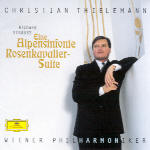Given his recordings to date, Christian Thielemann seems to be positioning himself as a German repertoire specialist. This may be a mistake, since he seems to have little natural affinity for German music. Of his existing recordings, only two (the Schumann Second Symphony and Schoenberg’s Pelleas and Melisande) might be termed completely successful. Two have been total disasters (Beethoven’s Fifth and Seventh, Schumann Third), and the rest (Pfitzner/Strauss opera preludes, Wagner bits, Orff’s Carmina Burana) are no better than average. It would be interesting to hear him in, say, Russian music, where his general inattention to matters of symphonic logic and structure matter less. In any event, this latest effort fits snugly into the “average” category.
The Vienna Philharmonic has recorded the Alpine Symphony twice before, for Previn (Telarc) and Ozawa (Philips), both performances more appealing than this one. Thielemann adds a couple of minutes to the overall timing of these other two performances, never a good idea in this sprawling piece, but his tempos aren’t particularly slow. It’s just that he fails to make the most of the many opportunities for contrast. At “Entry into the Woods”, for example, Strauss indicates that the hymn-like string passages at figures 27 and 28 are to be played more quickly (“somewhat livelier” and “again rather hurried”), and this elicits no response from Thielemann. He also injects insufficient energy into the accelerando leading to the “Alpine Fairy” episode, which in turn features some really ugly percussion sounds–more like disturbing a nest of rattlesnakes–and suffers from serious balance problems too. Those purely decorative downward violin glissandos in particular assume soloistic prominence.
Similarly, the cowbell episode lacks any hint of atmosphere, with simply a couple of clumps of bells shaken in defiance of Strauss’ carefully notated instructions regarding the manner in which they should approach and recede. “At the Summit” features some disappointingly weak, (supposedly) fortissimo trombones, and the grand unison theme for six horns (from the slow movement of Bruch’s First Violin Concerto) barely penetrates the mass of string tone. Is this really the Vienna Philharmonic? Finally, the storm comes off as an ill-balanced mess. Organ, timpani, and brass obliterate the lion’s share of instrumental detail, and while the result certainly makes noise, what sounds like one loud sustained chord after another buries the music’s real role as a sort of gigantic development of the work’s principal themes. Comparison with Ashkenazy’s recent Czech Philharmonic version (Canyon Classics), Previn’s VPO version on Telarc, or Kempe’s on EMI makes Thielemann’s musical inferiority quite obvious.
Part of the problem, no doubt, stems from the dry, unflattering live recording before a not-completely-silent audience (disturbing especially at the work’s quiet opening and closing sections); but in the final analysis it’s the conductor’s responsibility, for example, that solo tuba, trombone, and horn don’t balance in their successive entries before figure 5, or that the strings almost lose their tremolo a few bars before figure 75 trying to play more quietly than Strauss requires (they’re only marked piano). There are so many better performances of this piece, even with this orchestra, that inclusion of the Rosenkavalier Suite (also rendered with a comparatively heavy hand) hardly tips the balance in Thielemann’s favor.
































